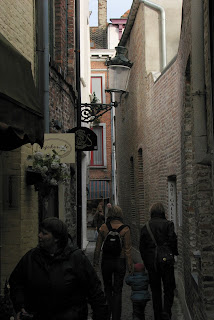TO ALL
Last August when I was at Cedarville with Deanna, I met two missionary families who were serving in Budapest. At some point in the conversation I asked “Is there any reason why I would want to go to Budapest as a tourist?” The answer was “Absolutely, Budapest is one of the five great cities of Europe – after London, Paris, Rome, and . . .and . . . and . . . . . ” Prague maybe? Or Vienna? (I can’t remember, now.) This claim was followed by a list of things I should be sure to see in Budapest. For whatever it is worth, I also learned that there are NO Starbucks in Budapest. The closest one is in Vienna. Don’t laugh, now. If you were a missionary and liked American coffee this would be important information. One of the missionary wives commented, “Most people go to Vienna to the opera. We go to Vienna to Starbucks. We’ve never been to the opera.” To each his own.

A month or so after that conversation, I began thinking about where we might go over Columbus Day weekend that we could FLY to cheaply. After driving to Rome and then to Norway, neither Mike nor I were ready to get into the car again for awhile. Ryanair had tickets to Bratislava, Slovakia for about $50 each round trip. Slovakia is the other half of what used to be Czechoslovakia. It turns out that Bratislava is about 2 hours from Budapest by train (another $15 round trip). So off we headed. And . . . after a 2-hour drive to the Frankfurt-Hahn airport, a 2-hour flight, a 2-hour layover in Bratislava and a 2-hour train ride, we found ourselves in one of the 2 cities (Buda and Pest) commonly referred to as Budapest (pronounced BOO-dah-peshhhhht) with 2 days to see the sights. Getting to our pension was another story. More about that later.
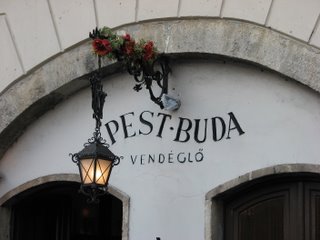
First a few basic facts about Budapest that you might not happen to be aware of –
(1) Budapest is in Hungary
(2) Hungary used to be behind the Iron Curtain.
(3) Hungarians are Magyars (pronounced MUD-jar)
(4) Magyars speak Hungarian which is NOT a Slavic language
(5) Hungarian is an agglutinative language which means that you start with a simple root word and then start tacking on suffixes to create meaning. Yes, Germans do this sometimes, too. But the Hungarians seem to have a corner on the market for long words. I doubt that supercalifragilisticexpialidocious would even create a stir in Hungary.

(6) Hungary is part of the European Union but they prefer to use their own currency which is the forint. The ratio of forints to dollars is 230 to 1. For the next 24 hours, try dividing every price you see by 230 and see what that does to your brain.
(7) Budapest is on the Donau River (a.k.a. the Danube River). Buda is on the west bank and Pest is on the east bank.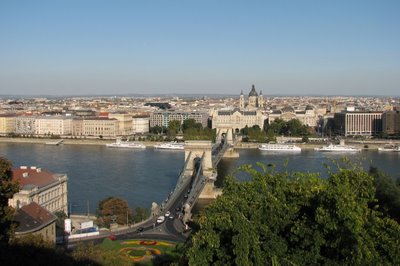
Pest from Buda
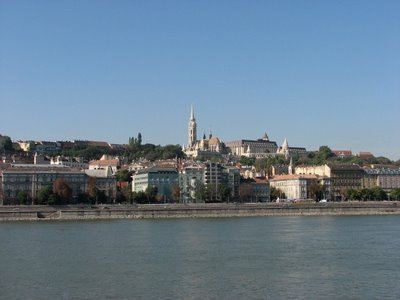
Buda from Pest
(8) The composer Ferenc Lizst (a.k.a. Franz Lizst) was Hungarian – sort of. His name is Hungarian and he loved his Magyar heritage. He was born in Germany and never spoke Hungarian but he spent the last 5 years of his life in Budapest. He seems to be Hungary’s only claim to fame, unless of course you count ---
(9) Attila the Hun who may or may not have been an ancestor of the Hungarians. Regardless, there is a Hungarian poet named Jozsef Attila so the name “Attila” shows up all over the place in Budapest.
We arrived in Pest at about 8:00PM having made a room reservation by email with Maria and Istvan. (Istvan is the Hungarian version of Steven and is pronounced EESHT-vahn) I thought I knew exactly how to get from the train station to Istvan’s place. Somehow nothing seemed to work quite right. But . . . . . . . . . . . Hungarians are friendly. No less than 4 different people, all of whom spoke at least some English, perceived, at various points along the way, that we were confused and offered to help. The last one delivered us right to Istvan and Maria’s doorstep. Our difficulties had primarily to do with a section of one of the metro lines being down for repairs and secondarily with some irregularities in the above ground transportation system due to a political demonstration having just ended about the time we arrived in town. All the demonstrators were trying to get home at the same time. As Alan says, we have now extended the reach of our travels to include areas of political unrest. Well, sort of. Actually the crowd of people we encountered on the steetcars could easily have been mistaken for a bunch of American college football fans on their way home from a game had we not known otherwise. However, our last “guardian angel” – a man with a very ruddy face that Mike was sure was an alcoholic who couldn’t be trusted – did inform us in no uncertain terms that “the Prime Minister of Hungary has big problems.” And unfortunately the demonstrating in Budapest has not always been as peaceful as it was while we were there.
Istvan and Maria turned out to be look-a-likes of Sam and Marie Lynn with personalities akin to Louie and Mary Trout. I’ll leave the four of you to speculate on that one. Suffice it to say they were very friendly and helpful. After flooding us with maps and other helpful info about Budapest and explaining about the FOUR different keys required to access our room, Istvan took charge of my suitcase and escorted us to our room which was about 6 blocks away in another building.
Our suitemate (shared bathroom and kitchen) was a young lady from Billings, Montana, named Monica Morey. Small world. Monica turned out to be a highlight of the trip. She is an R.N. Maybe . . . late 20’s? Went to some little college in Minnesota and worked at the Mayo Clinic in Rochester for several years. She is taking a year off to travel all over Europe. It was fun comparing notes with her about places we have been. She is also a great fan of Rick Steves, so we had lots of common experiences to talk about. However the really significant detail about Monica is that her middle name is Strohm. No kidding!!!!!! Her mother’s maiden name was Strohm. This little detail came to light as a result of Mike having for some reason decided to put a military namestrip on his bathroom bag. Imagine Monica stumbling into the bathroom after we left that first morning, half awake, and seeing her name, right in front of her nose, on someone else’s stuff! Needless to say, she came to see us that night when we got home with some serious questions! Like us, she has never before just “accidentally” met another Strohm. (well, almost never ---- see my Travelogue entitled “Summer Travels” for another “Strohm story”). Her mother’s relatives live in Kansas and Mike knows that he also has some relatives that live in Kansas, but neither of them knew enough details to determine just how closely they might be related.
After our first day in Budapest I informed Mike that I thought that Budapest was my favorite of the large European cities that we have visited so far. But then I had to admit that my opinion could have more to do with the weather being absolutely perfect and the crowds being minimal than anything else. 
Still, Budapest is a very pretty city, with lots of interesting history. Ironically, none of the buildings themselves are all that old. The story is that in 1896 Hungary celebrated the 1000 year anniversary of their ancestors’ arrival in Europe. Most of the significant buildings in the city were either built or rebuilt as part of the “sprucing up” they did in preparation for that celebration.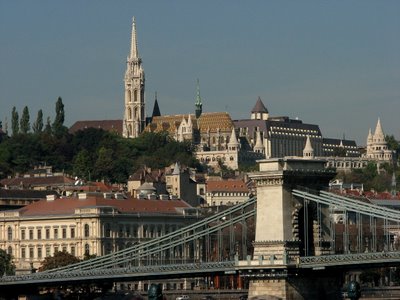
Castle Hill (in Buda) with the Chain Bridge in the foreground
The Parliament building is modeled after the one in London, though I think it is more attractive than the one in London. The roof is kind of a plum color that is really neat looking.


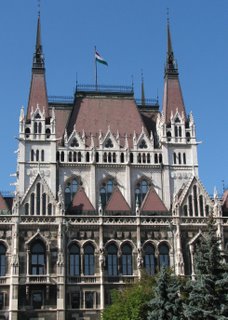
The Parliament building is right on the Donau River. On the non-river side of the building is Budapest’s version of Lafayette Square (behind the White House in Washington DC). This is where all the demonstrations that you may have heard about in the news have taken place. When we were there, there were a lot of tents set up and signs and Hungarian flags, etc. But nothing felt even remotely threatening or unsafe.

We did a lot of walking in Budapest. (On this trip Herr Glessner, we were quite peripatetic!) For the most part we didn’t feel compelled or inclined to go into any buildings. It was just interesting walking around observing things. Budapest is clearly an old city. The outsides of most buildings are worn and grimy – badly in need of a facelift – but the streets are clean and free of trash.
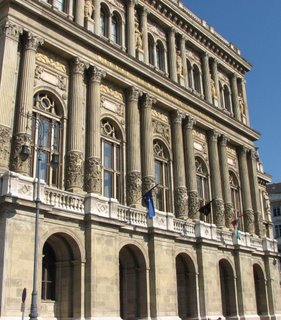
Thanks to a tip from Rick Steve’s we noticed that the bottom couple of floors and the entryways of many buildings are rather dull and utilitarian on the outside (compliments of the communists) but then from about the 3rd floor up the architecture is truly art. Apparently as things were renovated during the communist
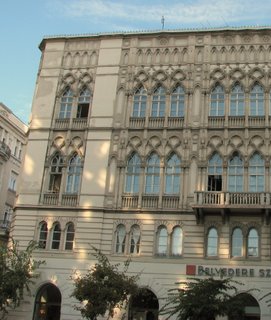
era they were made plain and utilitarian.
And . . .
maybe ground floors tend to get redone and upper floors don’t? Regardless, in Budapest, it pays to look up as you walk.
(So now . . . . if you were an archeologist digging up Budapest 2000 years from now, wouldn’t you draw all the wrong conclusions about the chronology of the Communist era in relationship to the other eras of Hungarian history? Hummmmm)
One other note about Hungarian architecture:
Hungarians are really into colorful mosaic tile roofs. We’ve seen these occasionally throughout Europe, but there are an inordinate number of them in Budapest.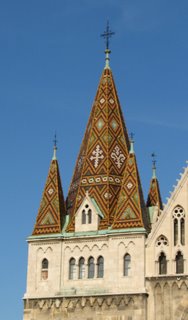
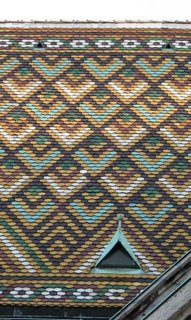
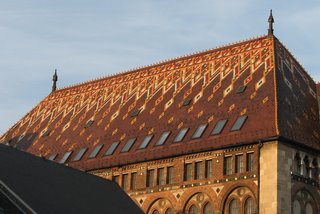
One of the buildings we did go into in Budapest was the House of Terror. The House of Terror is a museum dealing with the “double occupation” of Hungary – first by the Nazis and then by the Communists. The building itself was used by both the Nazi and the Communist secret police organizations and hundreds of people were actually executed in its basement during those eras. It reminded me a bit of the Holocaust museum in Washington D.C. in that it wasn’t just a historical archive that was open to the public. The displays were all very well thought out and carefully calculated to create a certain atmosphere and to evoke a certain response. The building is about 4 stories high and is square. The atrium features a Soviet tank and a wall covered with hundreds of black and white portraits of the victims of the building. A small stream of translucent oil runs continually out of the bottom of the tank and down the sides of the platform the tank sits on. (I tried to take a picture of this but was quickly rebuked. This time I was repentant and put my camera away. Have some of you been praying about my attitude or what?) Visitors are supposed to start on the top floor and work their way down to the basement were the executions actually took place. The basement walls are covered with pictures of the victimizers – both Nazi and Communist. Some of them are alive today and have never been brought to justice. (How did that happen?) Although there were English handouts available in every room, the wall plaques and display labels were all in Hungarian. That was a bit frustrating because the English handouts were basically just historical accounts that made no attempt to actually identify the items in the rooms. Just the same it was all very interesting and sobering.
House Of TerrorSunlight mirrors the word "terror"
from roof eve
A couple of personal thoughts / reactions before I move on:
(1) It certainly does seem that the Hungarians have been caught in a no win situation for most of the 20th century – beginning with the break up of the Hungarian empire after WWI followed first by Nazi aggression and then communist aggression. Even taking into account that this museum was put together by Hungarians and is for Hungarians, so it could be somewhat biased, one cannot help but feel blatantly appalled at what has been done to the Hungarians. In fact, our visit to this museum on the heels of just having read a book about the break up of the Ottoman Empire after WWI (“A Peace To End All Peace” by David Fromkin) added to my sense that the “settlement” after WWI was really poorly handled and to the extent that the US and Britain and France were responsible for that debacle, we have to take some responsible for WWII and the rest of the 20th century. (Okay, so don’t panic, that is as anti-US as Nancy gets!) But, having said all that, it DOES appear that the Hungarians actually allied themselves with Hitler initially -- supposedly not because they liked Hitler but in hopes of being able to retain some degree of autonomy in return. Understandable, I guess -- except that this sounds suspiciously like the strategy of several of the OT kings of Israel and/or Judah. Instead of looking to God for help, they rushed into alliances that looked politically wise on the surface but turned out to be disastrous. Dare I draw a parallel between the two situations? Also, I did some looking around on the internet after I got home and apparently some Jewish organizations are unhappy with the way things are presented at the House of Terror. They feel that the idea of Hungary being an enemy of Nazism has been overstated and that the persecution of the Jews in Hungary by the Hungarian government has been glossed over.
(2) The 1956 Uprising – I wish I understood this event a little better. Apparently the Communists actually appeared for awhile to be pulling out of Hungary. The Hungarians elected a leader and started thinking they were free when all of sudden the Communists turned their tanks around and attacked with a vengeance, killing 25,000 Hungarians in the process of regaining control. Did they change their mind about pulling out (Pharaoh style)? Or was the whole thing a trick from the start?  Mike and I actually have a friend from our pre-Army days, Gus Miklos, whose dad fled Hungary during the 1956 Uprising and ended up in the US. It was interesting to see the name “Miklos” in various places in Budapest.
Mike and I actually have a friend from our pre-Army days, Gus Miklos, whose dad fled Hungary during the 1956 Uprising and ended up in the US. It was interesting to see the name “Miklos” in various places in Budapest.
(3) I kind of wish that I had the courage to ask someone like Maria or Istvan (who are somewhat older than I) to talk about what it was like living under Communism. I guess I just never know if that is an appropriate thing to do – or if I can phrase my question in an appropriate way. Somehow it intrigues me to think that these people actually lived in an environment that I only know (and can only know) from “story books.” To actually rub shoulders with someone who lived right in the midst of it and not hear their story first-hand seems like a big mistake.
On a lighter note –
Having been so impressed by the street musicians in Vienna and knowing that Budapest was another “musical” city, we actually frequented the pedestrian malls somewhat intentionally to see what we might find. Nothing in Budapest topped the balalaika and accordion trio we heard in Vienna (see my travelogue called “Mostly Austria”), but there were some interesting acts:
a male violinist whose mother was sitting off to the side, clapping after each number and taking the coins that were put in his cup for safe-keeping;
a young lady violinist (same spot as the guy, different time of day) who was playing Broadway tunes (both of them had incredibly good sound);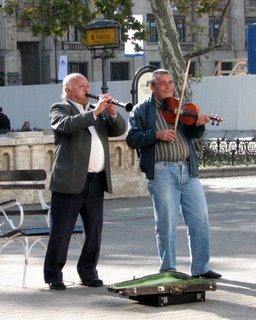
and two old men, one on the clarinet and the other on the violin playing Dixieland music. These last two were somewhat of an enigma. The clarinet player could not honestly be said to have any embouchure at all – let alone a good one -- and the spit dripped out the end of his clarinet continuously. The violinist did actually use a bow but he held his instrument more like a guitar and used it sort of like it was a percussion instrument. Yet the end result of all that was actually kind of pleasing and they were having so much fun and were such hams that one couldn’t help but respond positively.
I have developed the habit of tipping street musicians if they are any good at all. Being sort of a musician myself, I appreciate that a lot of money and effort goes into their training and the financial return tends to be meager. So it just seems right to help them out a bit. Plus they truly do add to my enjoyment of the day; they aren’t just beggars – wanting something for nothing. However, I found it hard to tip in Budapest. The idea of taking a bill with the number 200 written on it out of my pocket and giving it to some unknown person was more than I could handle. I could never quite convince myself that even though the bill said 200 on it, it was really only worth about one US dollar!
I am embarrassed to say that we never really got around to eating any authentic Hungarian food while we were in
Budapest.
Alan recently expressed his view that “our family doesn’t place enough value on eating good food when we travel.”
I acknowledged at the time that he was right, but I don’t seem to have succeeded in doing anything about it.
We ate about 4 meals in
Budapest and one of them was at Subway and another at Burger King.
Horrors!!!!!
The other two meals were in places with a little more ambience, but nothing truly Hungarian.
The most interesting food I ate in
Budapest was a cinnamon roll type thing, called a kalac, that I bought at a street fair near

our pension.
I actually watched these kalacs being made.
My mother was the official cinnamon roll guru in our family and she would have been impressed. The dough was rolled out pretty much like my mother would have done it, but then it was cut into long strips and wound around a spindle about the size of a large can of pork and beans. The spindle was mounted into a special oven that was designed to make it rotate slowly as it cooked. When it was done it was rolled in one of four different toppings (I chose the traditional cinnamon and sugar mixture. I’m not even sure what the other 3 were. The names were Hungarian.) Then somehow the roll was pushed off the spindle and handed to the customer--still hot -- in a plastic bag. I ate it by unwinding the roll and breaking off bite sized pieces. Yummmmm
The last night we were in
Budapest, we went for a walk along the Donau after dark.
At some point we realized that we were walking past a lot of big fancy boats and then it hit us that people were actually living on those boats . . . .
they were like . . . . .cruise ships!
Somehow neither Mike or I have ever had any huge urge to go on a ocean cruise.
Probably we will do it at least once someday and we may decide we like it, but right at the moment it’s not very high on our list of things we’d like to do.
But now . . . . . a European river cruise . . . . that might be a different story.
Start somewhere in
Eastern Europe and end up in
Germany a week or so later and see a different city every day.
That sounds like fun.
Unfortunately, I’ve since learned that river cruises are a LOT more expensive than say
. . . . a
Caribbean Cruise.
Oh, well.
It was a nice idea while it lasted.
I’m actually quite content with my present mode of travel.

Buda at night
So now, I’m caught up on travelogues and ready for the next adventure which is Belgium. We have chaplain friends that are living near Brussels and we are headed there next weekend.
Nancy
Additional Photos:
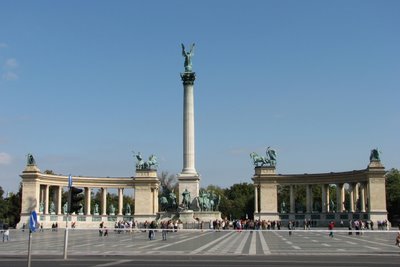
Hero's Square
The "heroes" have changed a couple of times over the years
depending on who in in power
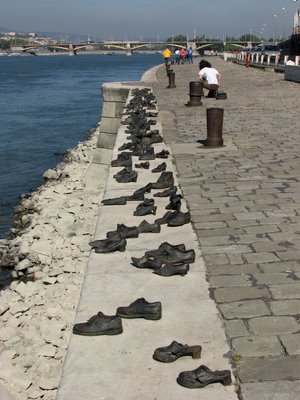
Have any of your shoes turned up missing lately?
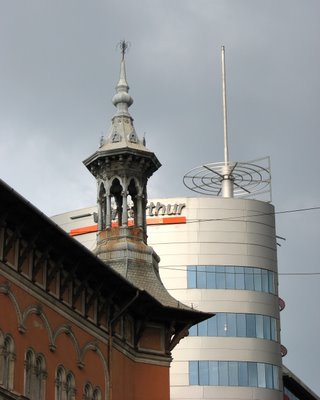
This is Europe --
The old and the new together


 compound), but leased by the US government and assigned to military personal when there isn’t enough of the government owned stuff available. Typically the housing office “shows” you two or three leased houses and you pick
compound), but leased by the US government and assigned to military personal when there isn’t enough of the government owned stuff available. Typically the housing office “shows” you two or three leased houses and you pick
 occupied by a
occupied by a  a whimper. Both of them are friendly, intelligent, easy-going, good-natured, flexible, extremely computer savvy, willing helpers in the kitchen, etc, etc, etc. Plus—they get along with each other! Not a hint of any friction between them the whole time we were there. Jeff and Rosalyn, how exactly did you do this? Jeff, do all your counselees walk out of your office with the formula for replicating this phenomenon in their own families?
a whimper. Both of them are friendly, intelligent, easy-going, good-natured, flexible, extremely computer savvy, willing helpers in the kitchen, etc, etc, etc. Plus—they get along with each other! Not a hint of any friction between them the whole time we were there. Jeff and Rosalyn, how exactly did you do this? Jeff, do all your counselees walk out of your office with the formula for replicating this phenomenon in their own families? 



 (5) Horse drawn carriages – most touristy European cities have these. In
(5) Horse drawn carriages – most touristy European cities have these. In  The Great Stables which are on the same grounds as the chateau are also very interesting. Supposedly one of the princes of Conde, who owned the estate prior to Henry d’Orleans, believed that he would be reincarnated as a horse and asked his architect to build some stables suitable to his rank. He clearly got what he asked for. These are some fancy stables – no heat but just about anything else you can imagine.
The Great Stables which are on the same grounds as the chateau are also very interesting. Supposedly one of the princes of Conde, who owned the estate prior to Henry d’Orleans, believed that he would be reincarnated as a horse and asked his architect to build some stables suitable to his rank. He clearly got what he asked for. These are some fancy stables – no heat but just about anything else you can imagine.
 Then we drove up the
Then we drove up the 
 All in all it was a really low-key but fun day. It could be repeated several more times, if any of you decide to come see us. However, time is getting short.
All in all it was a really low-key but fun day. It could be repeated several more times, if any of you decide to come see us. However, time is getting short. 





